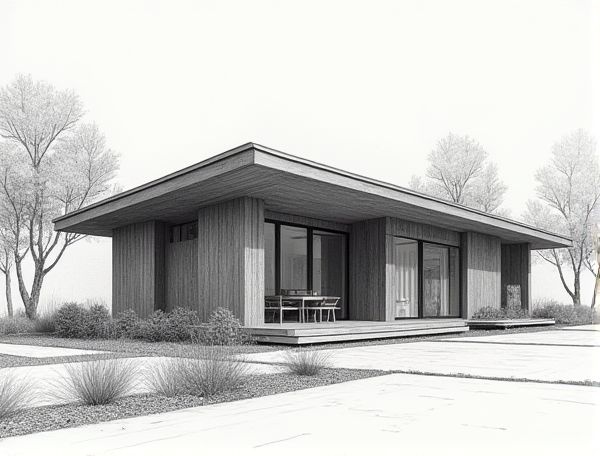
Photo illustration: Japandi home design with shou sugi ban cladding
Japandi home design emphasizes minimalism and natural materials, while shou sugi ban cladding adds a striking, charred wood texture that enhances durability and aesthetic appeal. Explore how incorporating this unique combination can transform Your living space by reading more in the article.
Introduction to Japandi Home Design
Japandi home design merges the minimalist elegance of Japanese aesthetics with the cozy warmth of Scandinavian interiors, creating a balanced, functional living space. Your home benefits from clean lines, natural materials, neutral color palettes, and an emphasis on simplicity and comfort, fostering tranquility and mindful living.
Key Principles of Japandi Aesthetics
Japandi aesthetics emphasize minimalism, combining Japanese wabi-sabi imperfection with Scandinavian functionality and simplicity. Natural materials such as wood, bamboo, and paper dominate, creating a warm yet uncluttered environment focused on balance and tranquility. The color palette consists of muted earth tones, soft neutrals, and occasional deep hues to harmonize space with nature and promote calmness.
The Art of Shou Sugi Ban: A Traditional Japanese Technique
Shou Sugi Ban, a traditional Japanese technique, involves charring cedar wood to enhance durability and create a striking blackened finish resistant to weather, insects, and fire. This ancient method preserves wood naturally while offering a unique texture and visual appeal, ideal for both exterior cladding and interior design elements. Modern architects embrace Shou Sugi Ban for sustainable, low-maintenance home exteriors that blend tradition with contemporary aesthetics.
Integrating Shou Sugi Ban Cladding in Modern Interiors
Shou Sugi Ban cladding, an ancient Japanese wood preservation technique, enhances modern interiors with its rich texture and deep charcoal hues, offering both aesthetic appeal and durability. Integrating this sustainable material into living spaces creates striking feature walls that provide natural fire resistance and longevity. Its unique, tactile surface complements minimalist and contemporary designs while promoting eco-friendly home solutions.
Color Palettes: Minimalism Meets Warmth
Neutral color palettes with shades of beige, soft grays, and warm whites create a minimalist foundation that exudes warmth and tranquility. Combining natural wood accents and muted earth tones enhances the cozy atmosphere while maintaining a sleek, uncluttered aesthetic. Strategic use of accent colors such as terracotta, olive green, or burnt orange adds depth and personality to minimalistic interiors without overwhelming the space.
Functional Furniture for Japandi Living Spaces
Functional furniture for Japandi living spaces combines minimalist Japanese design with cozy Scandinavian elements, emphasizing clean lines and natural materials like wood and bamboo. Your home benefits from multi-purpose pieces such as low-profile storage benches, modular shelving, and foldable tables that maximize space while maintaining aesthetic harmony. Incorporate neutral color palettes and tactile textiles to enhance comfort and practicality without sacrificing style.
Sustainable Materials and Eco-Friendly Choices
Using sustainable materials like bamboo, reclaimed wood, and recycled metal in home design reduces environmental impact and promotes durability. Eco-friendly choices such as low-VOC paints, energy-efficient appliances, and insulation made from natural fibers help maintain indoor air quality and lower energy consumption. Your commitment to these practices supports a healthier planet and creates a more comfortable, responsible living space.
Lighting Solutions to Enhance Japandi Ambiance
Incorporating warm, dimmable LED lighting with natural wood fixtures enhances the serene and minimalist Japandi ambiance, while strategic placement of floor lamps and pendant lights creates depth and cozy contrasts in your living space. Your lighting solutions should emphasize soft, indirect illumination to balance the fusion of Japanese simplicity and Scandinavian functionality.
Maintenance and Longevity of Shou Sugi Ban Surfaces
Shou Sugi Ban surfaces are highly durable due to their carbonized wood treatment, which increases resistance to rot, insects, and fire, significantly extending the lifespan of your home's exterior. Regular maintenance involves gentle cleaning with water and avoiding harsh chemicals to preserve the protective char layer, ensuring long-term aesthetic appeal and structural integrity. This eco-friendly technique reduces the need for frequent repairs, making your investment in Shou Sugi Ban both practical and sustainable.
Inspiring Japandi Home Designs Featuring Shou Sugi Ban
Japandi home designs seamlessly blend Japanese minimalism and Scandinavian functionality, while Shou Sugi Ban wood treatment enhances durability and adds striking charred textures. Incorporating Shou Sugi Ban in Japandi interiors creates a warm, natural aesthetic that emphasizes simplicity and sustainable craftsmanship.
 homedesy.com
homedesy.com